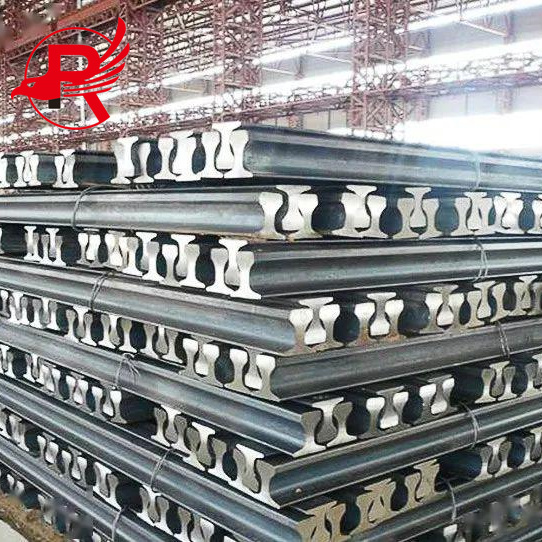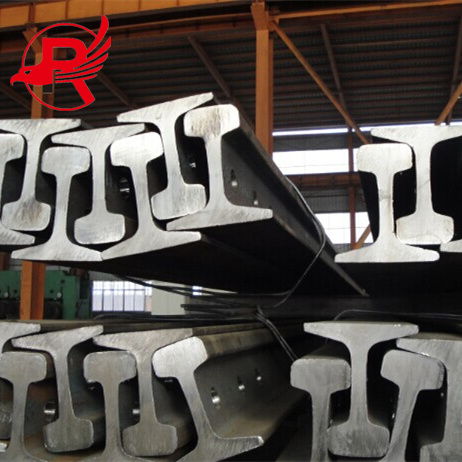ከአንድ ቦታ ወደ ሌላ ቦታ ስንጓዝ፣ የባቡር መሰረተ ልማት አውታሮችን ለስላሳ እና ቀልጣፋ የሚያደርገውን የባቡር መሠረተ ልማት አውታር እንደ ቀላል ነገር እንቆጥረዋለን። በዚህ መሠረተ ልማት እምብርት ውስጥ የባቡር ሀዲዶች መሰረታዊ አካል የሆኑት የብረት ሀዲዶች ናቸው. ከሚገኙት የተለያዩ የብረት ሀዲዶች መካከል የቢኤስ መስፈርትን የሚያከብሩ ሰዎች የባቡር ስርዓቶችን ደህንነት እና አስተማማኝነት ለማረጋገጥ ወሳኝ ሚና ይጫወታሉ.
BS መደበኛ የብረት ባቡርየብሪቲሽ ስታንዳርድ ባቡር በመባልም የሚታወቁት በብሪቲሽ ደረጃዎች ተቋም (BSI) በተቀመጠው መስፈርት መሰረት ተዘጋጅተው የተሠሩ ናቸው። እነዚህ የባቡር ሀዲዶች ጥብቅ የጥራት እና የአፈፃፀም መስፈርቶችን ለማሟላት የተነደፉ ናቸው, ይህም ለባቡር ግንባታ እና ጥገና ፕሮጀክቶች አስፈላጊ ምርጫ ያደርጋቸዋል. የ BS ደረጃን ማክበር የአረብ ብረት ሀዲዶችን በማምረት ረገድ የላቀ ፣ ረጅም ጊዜ እና ወጥነት ያለው ቁርጠኝነትን ያሳያል ፣ በመጨረሻም ለባቡር ስራዎች አጠቃላይ ቅልጥፍና እና ደህንነት አስተዋጽኦ ያደርጋል።
የ BS መደበኛ የብረት ሐዲዶች ቁልፍ ጥቅሞች አንዱ የላቀ ጥንካሬ እና ጥንካሬ ነው. እነዚህ የባቡር ሀዲዶች የተገነቡት ከፍተኛ ጥራት ያላቸውን የአረብ ብረት ቁሳቁሶችን በመጠቀም ነው እና ከባድ ሸክሞችን የመቋቋም ችሎታቸውን, ከፍተኛ የአየር ሁኔታን እና የማያቋርጥ መበላሸትን እና እንባዎችን ለመቋቋም ጥብቅ ሙከራዎችን ያደርጋሉ. በውጤቱም, ለቅርጽ, ለመስነጣጠል እና ለዝገት ልዩ የመቋቋም ችሎታ ይሰጣሉ, በዚህም የባቡር ሀዲዶችን ዕድሜ በማራዘም እና በተደጋጋሚ መተካት ወይም ጥገና አስፈላጊነትን ይቀንሳል. ይህ ዘላቂነት የባቡር መሰረተ ልማቶችን ታማኝነት ለመጠበቅ እና የስልጠና አገልግሎቶችን መቆራረጥን ለመከላከል አስፈላጊ ነው።
| BS11: 1985 መደበኛ ባቡር | |||||||
| ሞዴል | መጠን (ሚሜ) | ንጥረ ነገር | የቁሳቁስ ጥራት | ርዝመት | |||
| የጭንቅላት ስፋት | ከፍታ | የመሠረት ሰሌዳ | የወገብ ጥልቀት | (ኪግ/ሜ) | (ሜ) | ||
| አ(ሚሜ) | ቢ(ሚሜ) | ሲ(ሚሜ) | ዲ(ሚሜ) | ||||
| 500 | 52.39 | 100.01 | 100.01 | 10.32 | 24.833 | 700 | 6-18 |
| 60 አ | 57.15 | 114.3 | 109.54 | 11.11 | 30.618 | 900A | 6-18 |
| 60R | 57.15 | 114.3 | 109.54 | 11.11 | 29.822 | 700 | 6-18 |
| 70 አ | 60.32 | 123.82 | 111.12 | 12.3 | 34.807 | 900A | 8-25 |
| 75 አ | 61.91 | 128.59 | 14.3 | 12.7 | 37.455 | 900A | 8-25 |
| 75R | 61.91 | 128.59 | 122.24 | 13.1 | 37.041 | 900A | 8-25 |
| 80 አ | 63.5 | 133.35 | 117.47 | 13.1 | 39.761 | 900A | 8-25 |
| 80 አር | 63.5 | 133.35 | 127 | 13.49 | 39.674 | 900A | 8-25 |
| 90 አ | 66.67 | 142.88 | 127 | 13.89 | 45.099 | 900A | 8-25 |
| 100A | 69.85 | 152.4 | 133.35 | 15.08 | 50.182 | 900A | 8-25 |
| 113 አ | 69.85 | 158.75 | 139.7 | 20 | 56.398 | 900A | 8-25 |
ከጠንካራ ግንባታቸው በተጨማሪ፣የብረት መስመሮችትክክለኛ ልኬቶችን እና ጂኦሜትሪክ መቻቻልን ለማሟላት የተነደፉ ናቸው። ይህ የትክክለኛነት ደረጃ የባቡር ሀዲዶችን ለስላሳ እና የተረጋጋ እንቅስቃሴ ለማረጋገጥ ወሳኝ ነው። የ BS ስታንዳርድ ዝርዝሮችን በማክበር እነዚህ ሀዲዶች የሚመረቱት ወጥነት ያለው መስቀለኛ መንገድ መገለጫዎች፣ ቀጥታነት እና አሰላለፍ ሲሆን እነዚህም የዱካ ጉድለቶችን ለመቀነስ እና በባቡሮቹ ጎማዎች እና በባቡር ሀዲዶች መካከል ጥሩ ግንኙነት እንዲኖር አስፈላጊ ናቸው። የ BS ደረጃውን የጠበቀ የብረት ሀዲድ ትክክለኛ ጂኦሜትሪ ለባቡር ጉዞ አጠቃላይ ደህንነት እና ምቾት አስተዋጽኦ ያደርጋል ፣የመበላሸት አደጋን ይቀንሳል እና የባቡር ኔትወርክን አጠቃላይ የስራ ቅልጥፍናን ያሳድጋል።
በተጨማሪም የ BS ደረጃን ማክበር የአረብ ብረት መስመሮች በአምራች ሂደቱ ውስጥ ሙሉ የጥራት ቁጥጥር እርምጃዎችን እንደሚወስዱ ያረጋግጣል. ጥሬ ዕቃዎችን ከመምረጥ ጀምሮ እስከ መጨረሻው የተጠናቀቁ የባቡር ሀዲዶች ፍተሻ, ደረጃውን የጠበቀ ማክበር, የባቡር ሀዲዶች አስፈላጊውን የሜካኒካል ባህሪያት, የኬሚካል ስብጥር እና የአፈፃፀም ባህሪያትን የሚያሟሉ ዋስትናዎች. ይህ የጥራት ቁጥጥር ደረጃ በቢኤስ ደረጃውን የጠበቀ የብረት ሀዲድ አስተማማኝነት እና አፈፃፀም ላይ እምነትን ለማፍራት ፣የባቡር ኦፕሬተሮች እና የመሠረተ ልማት ሥራ አስኪያጆች የባቡር ሐዲዱ የከባድ ተረኛ የባቡር ሥራዎችን ፍላጎት በቋሚነት እንደሚያሟላ ማረጋገጫ ለመስጠት አስፈላጊ ነው።
የቢኤስ ደረጃውን የጠበቀ የብረት ሀዲድ ጠቀሜታ ከአካላዊ ባህሪያቸው በላይ ይዘልቃል፣ ምክንያቱም በአለም አቀፍ የባቡር ኢንደስትሪ ውስጥ መስተጋብርን እና ደረጃን በማሳደግ ረገድ ወሳኝ ሚና ስለሚጫወቱ። እንደ የቢኤስ ስታንዳርድ ያሉ እውቅና ያለው እና የተከበረ ደረጃን በማክበር የባቡር መሠረተ ልማት ፕሮጄክቶች ከተለያዩ የሮል ክምችት፣ የምልክት መስጫ ስርዓቶች እና የጥገና መሳሪያዎች ጋር ተመሳሳይ ደረጃን ካሟሉ የባቡር ሀዲዶች ጋር ያለምንም እንከን ለመገጣጠም የተነደፉ ጥቅሞችን ሊያገኙ ይችላሉ። ይህ መስተጋብር ለባቡር መሠረተ ልማት ግዥ፣ ተከላ እና የጥገና ሂደቶችን ያቃልላል፣ በመጨረሻም ለባቡር ኦፕሬተሮች እና ባለስልጣኖች ወጪ ቆጣቢነት እና የአሰራር ቅልጥፍናን ያመጣል።


በማጠቃለያው, የቢኤስ አጠቃቀምመደበኛ ባቡርለዘመናዊ የባቡር መሰረተ ልማቶች ልማት፣ ማስፋፊያ እና ጥገና ቀዳሚ ነው። እነዚህ የባቡር ሀዲዶች የጥራት፣ የጥንካሬ፣ የትክክለኝነት እና የመተጋገዝ መርሆዎችን ያካተቱ ሲሆን እነዚህ ሁሉ የባቡር መረቦችን ደህንነቱ የተጠበቀ እና ቀልጣፋ አሰራርን ለማረጋገጥ አስፈላጊ ናቸው። አስተማማኝ እና ከፍተኛ አፈጻጸም ያለው የባቡር መስመር ፍላጎት እያደገ በመምጣቱ፣ የቢኤስ ደረጃውን የጠበቀ የብረት ሐዲድ የባቡር ትራንስፖርት የወደፊት ዕጣ ፈንታን በመቅረጽ ረገድ ያለው ሚና ሊጋነን አይችልም። በብሪቲሽ ስታንዳርድ ኢንስቲትዩት የተቀመጡትን መመዘኛዎች በመጠበቅ፣የባቡር ኢንዱስትሪው በሰዎች እና በሸቀጦች እንቅስቃሴ በራስ መተማመን እና አስተማማኝነት ለመደገፍ በተረጋገጡ የ BS ደረጃ የብረት ሀዲዶች አቅም ላይ መደገፉን መቀጠል ይችላል።
የፖስታ ሰአት፡- ግንቦት-23-2024
